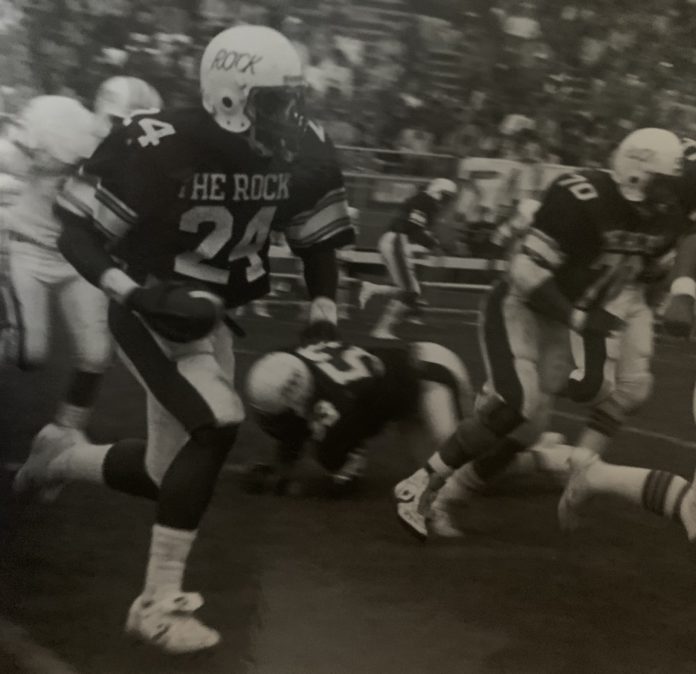“Sometimes Plan B is better than Plan A, you learn in life,” the 56-year-old man advises over a Zoom call.
Outfitted in a white t-shirt with gray sleeves and glasses without lens frames sitting atop his nose, his appearance doesn’t particularly resemble that of the athlete he’d been over 30 years earlier. His wife even calls to let him know she picked up his prescriptions.
Former Slippery Rock University running back Chuck Sanders’ original Plan B was an unforeseen one. He would tell that he was “nowhere near a star player” in high school at Penn Hills. He hadn’t even made an all-conference team and, initially, he intended on working for his father’s construction company.
However, a friend of his had received a scholarship to play football at Slippery Rock and, as fate would have it, something popped up where his dad couldn’t take him to the school. He asked Sanders if he could get a ride.
“When I was dropping him off, the football coach at the time, Don Ault, [saw] me,” Sanders says. “He said, ‘Hey, I’ve seen you on the film also, where are you playing football?’”
Sanders told him that he wasn’t playing anywhere. For all he was concerned, he was done wearing shoulder pads and a helmet. Ault couldn’t offer a scholarship, but, hinging on grades, he invited Sanders to attend SRU.
Sanders’ dad offered to pay tuition if he could get in. Two weeks after submitting his application, Chuck Sanders was on the football team at The Rock.
With scholarship players ahead of him in the meeting room, Sanders hit a late growth spurt his freshman year, sprouting a few inches taller and gaining around 35 pounds.
“Immediately, it became obvious that I was one of the more talented people on the team,” he said, adding that he’d soon climb to the top of the depth chart and stay there until graduating.
He also recounts a unique circumstance that helped him take the job from the good-looking incumbent starter.
“He was lightning fast,” Sanders says. “He could move, shake, everything. And the guy was gorgeous […] I can’t make this story up.”
Playboy Magazine, Sanders says, would bounce around different campuses, and in this situation, they were featuring Slippery Rock.
“The [Playboy] playmate and [the starter] ran off,” he says. “He quit the team and ran off with a [Playboy] playmate. And that was my opportunity.”
It’s sureness that Sanders attributes to his success while toting the football at Slippery Rock. He was a self-described big fish in a small pond. In the time period that he played collegiately, Div. II was the road less traveled to the professional level of the game. The opportunity to show his skills in a competitive setting early on helped pave the way for him to eventually get drafted.
“It was interesting, because I think I was one of that first wave of [Div. II players to reach the pros],” Sanders says. “You dominated and you played so much because you had the confidence. If I’d went to Pitt, yeah, I might’ve started, but it would’ve been my senior year. One year. And I might’ve lost confidence.”
At one point, John Carpenter, SRU’s sports information director at the time, approached Sanders with a thought that appeared zany to most.
“He was like, ‘You’re coming off of an All-American year, you led the nation in rushing your junior year. We really want to put a campaign [together] and start it out, pretty much tongue-in-cheek, [for] a Heisman candidate from Div. II football,’” Sanders says. “I’m positive it was the first time [it was ever done].”
Before the 1985 schedule, Carpenter sent postcards to media all over the country, announcing Sanders as the upcoming season’s first Heisman candidate. The tailback even made an appearance on Good Morning America. To this day, no player outside of Div. I has ever received the award, so, naturally, it was all taken as a gag.
The lobbying for Sanders to win the most prestigious trophy in all of college football did what it was intended to. Sanders reminds that football is about gaining exposure for most educational institutions and, then striving for a degree in marketing and management, he was excited throughout by the promotion aspect of the movement.
Admittedly, though, it all placed added pressure on Sanders when play commenced.
“The beginning of the season, [with] all of these news people coming to the games, my first couple of games were shaky,” Sanders says. “Because, now, the spotlight was so much bigger and I couldn’t just concentrate on playing ball.”
The East-West Shrine Bowl, following Sanders’ senior season, was his first wake-up call. When he arrived for the postseason college all-star game, he confesses, the names and alma maters of the other players shook his conviction. He didn’t play well. The stage had intimidated the normally-collected All-American.
“I even remember, when we went around the room and you said what school you were from,” Sanders laughs, his eyes darting back and forth. “I was like, ‘Slippery Rock-Pitt.’ Everyone was like, ‘What school is that? Slippery Rock? Or Pitt?’ All the jokes started. Where is it? Slimy pebble, all of that.”
Still, he was hoping for his chance to join a franchise at the next level. Draft coverage in 1986 was not the same as draft coverage today. ESPN was, for all intents and purposes, still in its stages of infancy. Later rounds of the event, Sanders says, were not broadcast over television.
“Me and my buddy were living out on Route 8,” Sanders says. “We had a little shack. There was a communal phone that everybody used. Somebody called me and said, ‘Chuck, there’s a phone call for you.’ I go get on the phone and it was [San Diego head coach] Don Coryell.”
Selected with the 293rd turn, in a round that no longer exists, Sanders was buzzing with excitement at the thought of packing up and leaving for Southern California and the Chargers.
“The girlfriend I was dating at the time—I can’t believe this—but somehow, some way, she had a San Diego Charger hat,” Sanders says. “I was like, ‘How the heck? How could you possibly know?’”
Sanders touched down in San Diego and instantly fell for the difference in living. Practicing alongside icons such as Kellen Winslow and taking handoffs from quarterback Dan Fouts, Sanders says he was scared to death. He wasn’t yet prepared for what came with being in the league.
San Diego was too much of a good time, Sanders says, that’s why it was a short time.
“Real soon, [San Diego] was like, ‘Look, we like you, but you’re just not ready for this level of team. We’re going to let you go, but trade you,’” Sanders says.
He perked up. Was he going to play for the Raiders? For the Chiefs? No, Pittsburgh.
Sanders reenacts his incredulity, “I was like, ‘Wait, you’re sending me back home?’”
There were burdens and distractions in being back in the place he’d knew his entire life. Everybody wanted tickets or to critique his game, Sanders says. He believes his playing career might have lasted longer had he not suited up for the Steelers, but also that his business career wouldn’t have taken off in the way that it did.
During one of his first practices with the Steelers, Sanders was approached by Art Rooney Sr., known as “The Chief.” The owner asked him if his dad went by Charlie. Sanders was taken aback, wondering how Rooney knew his father. The team’s founder told Sanders how he remembered his dad’s trucks coming back and forth to help build Three Rivers Stadium.
“My chest just blew up,” Sanders says. “I was like, ‘Mr. Rooney knows my dad is a businessman.’ And my dad was my idol.”
All said, Sanders played in 19 games with the Steelers, carrying the ball a total of 15 times for 77 yards and a score. He found himself attending events off the field, starting his networking while still employed by his hometown team.
Cut from rosters seven times during his career, he had to think of when to walk away. After speaking with his pastor, Sanders was content with his football life and the fact that he’d made it as far as he had. He looked at the man in the mirror and was realistic. He wasn’t Walter Payton, but there was much more to come.
“My big paradigm shift was, stop looking at yourself as an old football player,” Sanders says, “and start looking at yourself as a young CEO.”
Sanders doesn’t take full credit for opening the door for other Slippery Rock players, such as Marcus Martin and Wes Hills, to step foot in the league.
“The idea that somebody could even get to the NFL from Slippery Rock, for me, started with Ricky Porter,” he says, admiring the first member of SRU’s program to ever get drafted. “Now, I think because on the Heisman Trophy [campaign], because of the All-American [honor], because of the leading the nation in rushing, I really put a lot more eyes on it […] I definitely was one of the trailblazers […] and it’s something I’m extremely proud of.”
Football helped Sanders network, but it was his schooling that put him in a better position to succeed when he hung his cleats up, helping him parlay his experience into a career in business.
“My dad had a sixth-grade education,” Sanders says. “It does help me when I’m talking to younger people to be able to say I graduated from college. I’ve made way more money off of my degree than I have off of football.”
Sanders began his own small marketing company. Each day, he combed through the business section of the newspaper. At a point, he noticed that a man named Bob Murphy had started a semi-pro basketball team in the Continental Basketball Association. Sanders reached out and was brought on to help with marketing and management.
The league didn’t end up turning out as Murphy hoped, but Sanders picked up on the man’s wealth and golf course ownership.
“I finally got to a point where we were [cool] enough where I could ask, ‘What do you do? How did you make all of your money?’ That’s when he explained the mortgage business to me. And the mortgage servicing business. Title, appraisal, closing, back office work. That’s when I said to him, ‘I want to work there. I want to work for your mortgage company.’”
Murphy was somewhat confused, thinking that Sanders wanted to remain on the sports side of things. Rather, Sanders desired to be on the side that bought the team.
Sanders worked under Murphy for about five years at ValuAmerica, learning the business, then started his own company, which eventually came to be known as Urban Living Solutions in 2000.
“It just took off from there,” Sanders says. “I definitely became the largest minority-owned company, and one of the top companies in the country, in providing mortgage solutions […] At our peak, we were No. 8 in the country, doing about $250 million a year.”
His company grew to over 4,000 employees with offices in Denver, Pittsburgh, and Detroit. The biggest growth in the company, he says, happened during the real estate crisis that began in 2007. He started selling the company in 2012, starting a charity along the way. He’s also opened SAVOY Restaurant and worked with the medical marijuana business, as well.
Sanders acknowledges racial challenges in his line of work. Systemic racism is present, he says, yet some institutions don’t even recognize it.
“Let’s be real,” Sanders says. “[Real wealth for black people usually] comes out of sports. There aren’t too many 6’8” LeBron James’s. We should be able to have more foundation as minorities to build businesses that can lead to generational wealth. Because that’s where you really make a change.”
Because of COVID-19, Sanders senses another housing crisis. He’s started a new company, Diverse Mortgage Solutions, to work with banks on modifying loans and help families stay in their homes.
“I’m after Jay-Z,” Sanders says. “I want his money. I’m after Warren Buffett. There’s always a ladder to go up after.”








